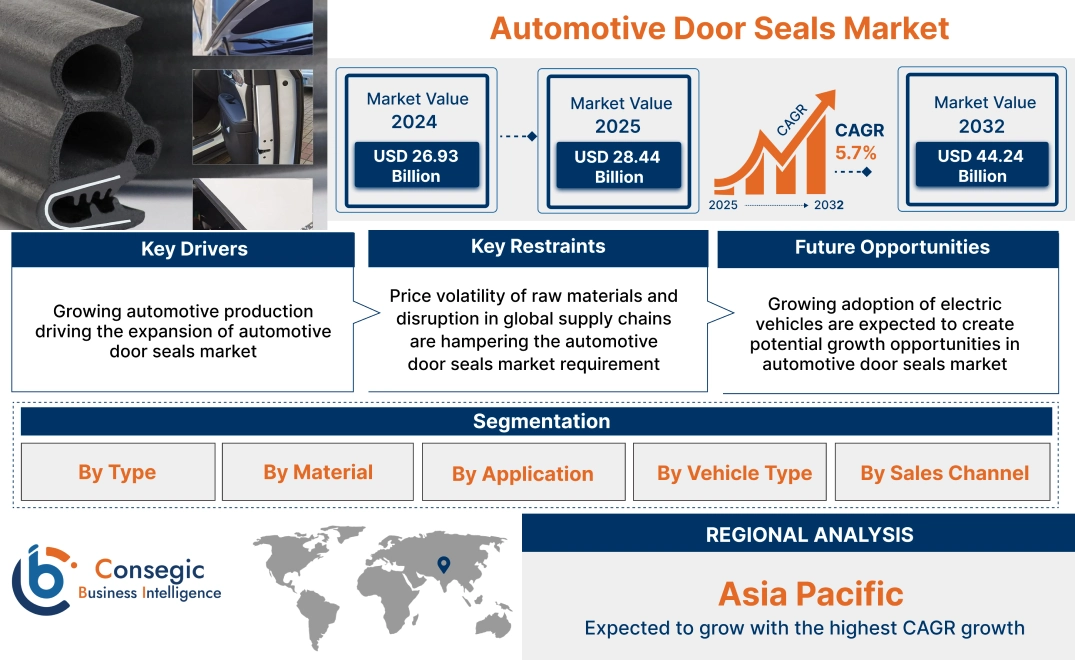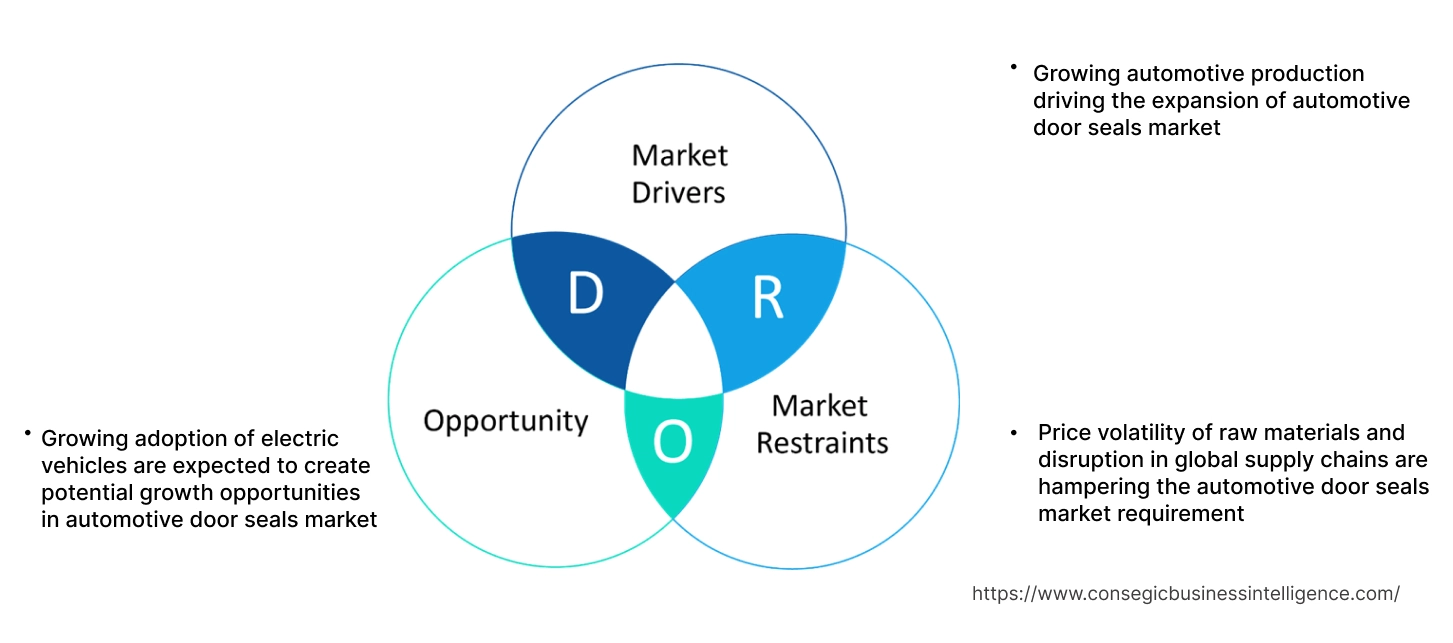- Summary
- Table Of Content
- Methodology
Automotive Door Seals Market Size:
Automotive Door Seals Market Size is estimated to reach over USD 44.24 Billion by 2032 from a value of USD 26.93 Billion in 2024 and is projected to grow by USD 28.44 Billion in 2025, growing at a CAGR of 5.7% from 2025 to 2032.
Automotive Door Seals Market Scope & Overview:
Door seals are essential elements that create a barrier between the interior and exterior environments, inhibiting the entry of water, dust, noise, and other pollutants into the vehicle cabin. As automotive manufacturers aim to improve vehicle efficiency, durability, and passenger comfort, the demand for high-quality door seals continues to rise. The automotive door market is influenced by various factors, including the increasing global production and sales of automobiles, stringent government regulations regarding vehicle safety and emissions, and changing consumer preferences for quieter and more refined driving experiences.
Key Drivers:
Growing automotive production driving the expansion of automotive door seals market
The increasing demand for automobiles in different regions is prompting manufacturers to enhance their production capacities, subsequently driving up the demand for door seals in the automotive sector. These seals are essential for maintaining the integrity of a vehicle's interior by preventing dust, water, and noise from entering the cabin, thus improving passenger comfort and the driving experience. Additionally, stringent regulations concerning vehicle safety and emissions are driving automotive manufacturers to enhance the overall quality of the vehicles, including door sealing systems. Consequently, there is a growing implementation of advanced materials and technologies in automotive door seals, such as thermoplastic elastomers and EPDM rubber, to comply with regulatory standards and improve performance.
- For instance, according to IEA, electric car sales experienced variation across regions however China remained the dominant player. In 2022, battery electric vehicle (BEV) sales in China rose by 60% compared to 2021, reaching 4. 4 million units, while plug-in hybrid electric vehicle (PHEV) sales nearly tripled to 1. 5 million units.
Thus, according to the automotive door seals market analysis, increasing demand for automobiles and stringent government regulations are driving the automotive door seals market size.
Key Restraints:
Price volatility of raw materials and disruption in global supply chains are hampering the automotive door seals market requirement
The global market encounters considerable challenges due to the price volatility of raw materials, especially natural rubber and synthetic alternatives such as ethylene propylene diene monomer (EPDM). Various factors, including unpredictable weather patterns, geopolitical tensions, and fluctuations in global supply and demand, influence rubber prices. In North America, the volatility was apparent in the third quarter of 2023, with natural rubber prices varying from an average of USD 1,345 per metric ton in July to USD 1,140 per ton by September, signifying a decrease of 5. 77%. This erratic pricing introduces uncertainty for manufacturers, complicating their procurement strategies and inventory management.
Further, the intricacy of the automotive supply chain, characterized by multiple tiers of suppliers across various regions, intensified the effects of disruptions. Even when production resumed in some locations, logistical bottlenecks and capacity constraints delayed the delivery of components to assembly plants, resulting in postponements in vehicle production. Consequently, this impacted the demand for door seals, as automakers adjusted their production schedules in response to the changing circumstances. These factors and analysis are hindering the progress of the automotive door seals market trends.
Future Opportunities :
Growing adoption of electric vehicles are expected to create potential growth opportunities in automotive door seals market
The rapid expansion of electric vehicles (EVs) presents a substantial opportunity for the global market. EVs necessitate specialized door seals to ensure battery protection, manage thermal conditions, and reduce noise, all of which are essential for improving vehicle safety, efficiency, and comfort. In 2024, EV sales are anticipated to reach 16.6 billion units, representing 19.2% of the light-vehicle market, with plug-in deliveries expected to increase by 17%. According to the International Energy Agency (IEA), sales of internal combustion engine (ICE) vehicles are projected to cease by 2035 under the Net Zero Emissions by 2050, while EVs are expected to constitute 60% of total sales by 2030. The drive toward zero emissions, alongside advancements in battery technology and government incentives, is hastening the adoption of EVs.
- For instance, Trelleborg Sealing Solutions have designed HiSpin Seals, a high-speed rotary seals to improve next-generation e-axels. E-axles represent a significant advancement in electric vehicle technology, integrating the electric motor and gearbox into a single unit. This next generation sealing technology allows electric cars to achieve the primary objective of traveling the same distance on a single charge as a traditional gasoline vehicle.
Thus, based on the above analysis, the rapid development of electric vehicles globally is driving the automotive door seals market opportunities.
Automotive Door Seals Market Segmental Analysis :
By Type:
Based on the type, the market is segmented into O-ring seals, rotary seals, lip seals, mechanical seals, and others.
Trends in the type:
- Manufacturers within the automotive sector are operating on the cutting-edge technologies of material science and engineering, while constantly pushing boundaries to develop advanced door seals that withstand diverse environmental conditions.
- Modern consumers emphasize comfort and safety features. Door seals are essential in minimizing noise, vibration, and harshness (NVH) levels inside the vehicle, thereby enhancing passenger comfort. Additionally, they aid in safety by preventing water intrusion and ensuring secure door closure.
O-ring seals segment accounted for the largest revenue share of 33.41% in the year 2024.
- Governments worldwide are enacting stricter emission regulations to address climate change. This trend is prompting the development of more fuel-efficient vehicles, which often necessitate enhanced sealing technologies to reduce air leaks and optimize engine performance.
- O-ring seals provide an effective solution for improving fuel economy. The low maintenance and durability of the seals are contributing to the increased adoption of O-ring seals in automobile components, thus propelling the growth of the O-ring seals’ segment. Additionally, the segment is projected to benefit from stringent regulations imposed by automotive organizations and agencies concerning the permissible limits of toxic gas emissions such as carbon monoxide and nitrogen oxide.
- For instance, in October 2023, Freudenberg has introduced a new polyurethane-based compound, '98 AU 30500,' which serves as a highly effective alternative to traditional PTFE seals. This development marks a significant advancement in mobile hydraulic sealing systems. According to FST, the new material '98 AU 30500' exhibits outstanding hydrolysis resistance and demonstrates a performance profile that surpasses that of conventional PTFE types.
- The stricter emission regulations and development of fuel-efficient vehicles would further drive the automotive door seals market during the forecast period.
Mechanical seals segment is anticipated to register the fastest CAGR during the forecast period.
- Mechanical seals are essential components that prevent fluid leakage and enhance the operational efficiency of machinery. The importance of mechanical seals is underscored by their capacity to endure a range of pressures and temperatures, ensuring reliable performance across various conditions.
- Consumers and governments are focusing more on fuel-efficient vehicles. Mechanical ring seals support this trend by reducing aerodynamic drag, thereby improving a vehicle's fuel economy.
- Thus, based on the analysis these factors and developments are driving the automotive door seals market size and trends during the forecast period.
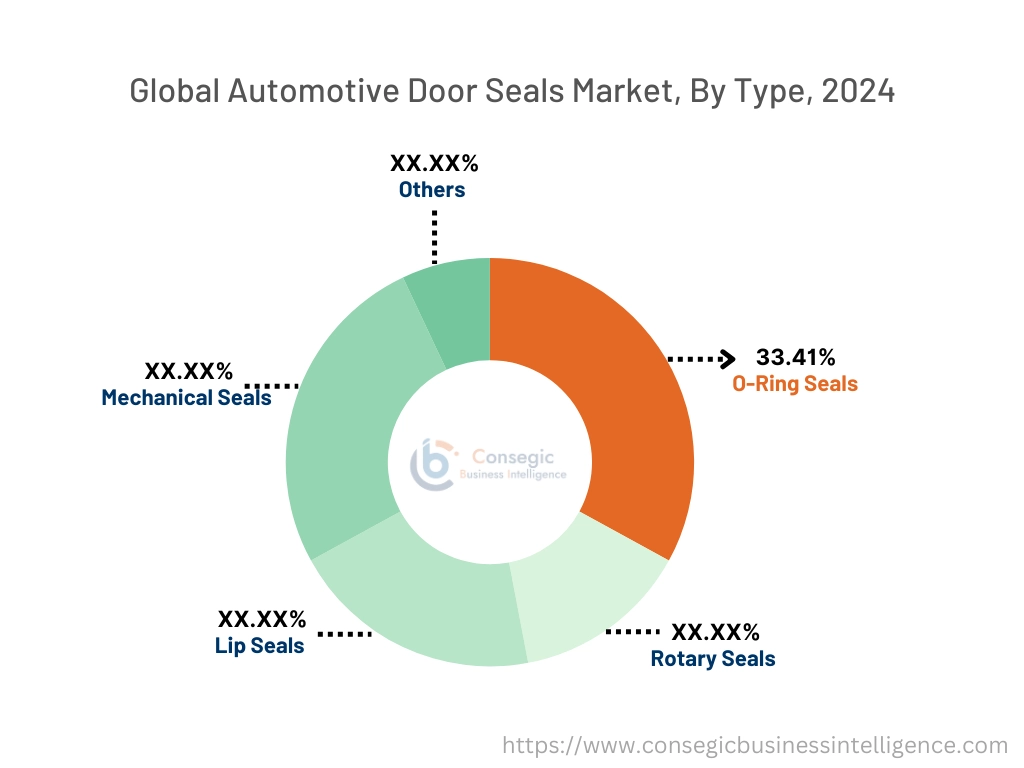
By Material:
Based on the material, the market is segmented into rubber, sponge, plastic, foam, and others.
Trends in material:
- Sponge door seals offer effective sealing while accommodating variations in door gaps and surface irregularities. Their lightweight design contributes to overall vehicle weight reduction, thereby enhancing fuel efficiency and lowering emissions.
- The others category includes various materials such as thermoplastics, thermoplastic elastomers (TPE), and hybrid compounds. These materials provide distinct benefits such as improved flexibility, chemical resistance, and cost-effectiveness. The integration of alternative materials in automotive door seals is driven by factors such as regulatory requirements, technological advancements, and cost considerations.
Rubber segment accounted for the largest revenue share in the year 2024 and is expected to register the highest CAGR during the forecast period.
- The rubber segment dominates the market due to its flexibility, durability, and cost-effectiveness. Rubber door seals provide excellent noise insulation and watertightness, enhancing cabin comfort while safeguarding against external elements.
- The continuous innovations in rubber formulations and manufacturing processes, makes the segment to witness steady growth during the forecast period.
- For instance, Cooper Standard has launched automotive door seals constructed from EPDM rubber, renowned for its outstanding weather resistance, which makes it suitable for a wide range of vehicles in various climate conditions.
- Therefore, based on the above automotive door seals market analysis, the rubber segment will be dominating the market during the forecast period.
By Application:
Based on the application, the market is segmented into weather stripping, noise insulation, vibration control, and aesthetic enhancement.
Trends in the application:
- The incorporation of advanced technologies, such as active noise cancellation systems and electronic control units (ECUs), is fostering innovation.
- The growing consumer inclination towards customization is driving the demand for seals that can be adapted to specific vehicle designs and aesthetics.
Noise insulation accounted for the largest revenue share in the year 2024 and is expected to register the highest CAGR during the forecast period.
- The segment has experienced consistent growth in recent years, influenced by various factors including the rising need for passenger vehicles, advancements in material technology, and rigorous regulatory standards for vehicle safety and noise reduction.
- Automotive door seals are essential for ensuring cabin comfort by blocking the entry of water, dust, and noise from outside. As automotive manufacturers aim to improve the overall quality and durability of their vehicles, the need for high-performance door seals has increased significantly.
- There has been a marked shift towards the use of advanced materials and manufacturing technologies in the automotive door seal sector. Manufacturers are increasingly dedicated to creating lightweight yet robust seals that provide enhanced sealing performance while reducing weight and material consumption.
- There is an increasing focus on incorporating smart features into door seals, including sensors for monitoring door status and weather conditions, as well as adaptive sealing systems that can modify their properties in response to environmental changes.
- In September 2024, Toyoda Gosei Co., Ltd. developed a new system that facilitates automotive developers to experience changes in vehicles interior sounds with several combinations of the sealing parts installed on the vehicles. Electric vehicles and fuel cell vehicles, which are becoming more prevalent, operate more quietly than traditional vehicles due to their motor-driven design and absence of engine noise. As a result, increased levels of wind and road noise are experienced, necessitating improved sound insulation components.
- The growing need for passenger vehicles and advancements in material technology would further drive the market during the forecast period.
By Vehicle Type:
Based on the vehicle type, the market is segmented into passenger vehicles and commercial vehicles.
Trends in the vehicle type:
- The global market is experiencing a significant growth driven the increasing production of commercial and passenger vehicles. In 2023, global automotive production reached around 93.5 billion units, according to Organisation Internationale des Constructeurs d'Automobiles (OICA). This increase is attributed to heightened production rates and significant order gains from major manufacturers such as Cooper Standard Holdings Inc. and Hutchinson S. A. As automotive producers enhance their production capacities to satisfy growing needs, while the requirement for high-quality door seals will inevitably increase.
- The focus on lightweight solutions aligns with the industry's overarching objectives of sustainability and efficiency. Furthermore, rising urbanization is creating need for compact vehicles, which heightens the need for automotive door seals suitable for commercial and passenger vehicles. Overall, the changing dynamics of the automotive industry signal significant transformations in door seal applications, promoting innovation and development, trends, and opportunities in all types of vehicles.
Passenger vehicles accounted for the largest revenue share in the year 2024 and is expected to register the highest CAGR during the forecast period.
- The increasing environmental concerns are boosting the requirements for eco-friendly and recyclable sealing materials, including bio-based rubbers and recycled plastics.
- Door seals are progressively being integrated with advanced technologies such as active noise cancellation systems and electronic control units (ECUs) to improve their performance.
- As vehicle customization becomes more prevalent, there is an escalating need for door seals that can be tailored to specific vehicle designs and customer preferences.
- In June 2023, Gabriel India Limited, a flagship company of Anand Group, announced that they have manufactured components of Maruti Suzuki and Stellantis electric Citroen C3.
- The growing environmental concerns and advancements in technologies would further drive the global market during the forecast period.
By Sales Channel:
Based on the sales channel, the market is segmented into OEMs and aftermarket.
Trends in the sales channel:
- As fuel efficiency gains prominence, vehicle manufacturers are prioritizing enhancements in aerodynamics and the reduction of wind resistance.
- The automotive industry is placing greater emphasis on the use of recycled and eco-friendly materials. In response, door seal manufacturers are innovating sustainable materials and production processes.
OEMs segment accounted for the largest revenue share in the year 2024.
- The OEM segment includes companies engaged in the production of vehicles, such as cars, trucks, and other automotive types. These manufacturers acquire door seals as part of their overall production process to ensure quality, durability, and safety standards in their vehicles.
- OEMs frequently enter long-term contracts with door seal suppliers to ensure a consistent and dependable supply chain for their manufacturing activities.
- OEMs depend significantly on high-quality sealing solutions to comply with rigorous quality and safety standards in new vehicle production. As manufacturers focus on quality, the need for innovative and reliable door seal technologies within the OEM sector is steadily increasing.
- These factors would further drive the global market during the forecast period.
Aftermarket segment is anticipated to register the fastest CAGR during the forecast period.
- Consumers often seek aftermarket door seal replacements due to wear and tear, damage, or customization requirements. This segment capitalizes on the need for maintenance and repair services, providing an extensive variety of door seal options for different vehicle makes and models.
- Aftermarket suppliers typically emphasize competitive pricing, convenience, and accessibility to appeal to customers looking for affordable automotive solutions.
- Aftermarket companies frequently implement marketing initiatives and distribution strategies to connect with end-users directly or through intermediaries such as auto parts retailers and online platforms.
- Thus, based on the analysis, the focus on competitive pricing and need for affordable automotive solutions would further drive the automotive door seals market trends during the forecast period.
Regional Analysis:
The global market has been classified by region into North America, Europe, Asia-Pacific, MEA, and Latin America.
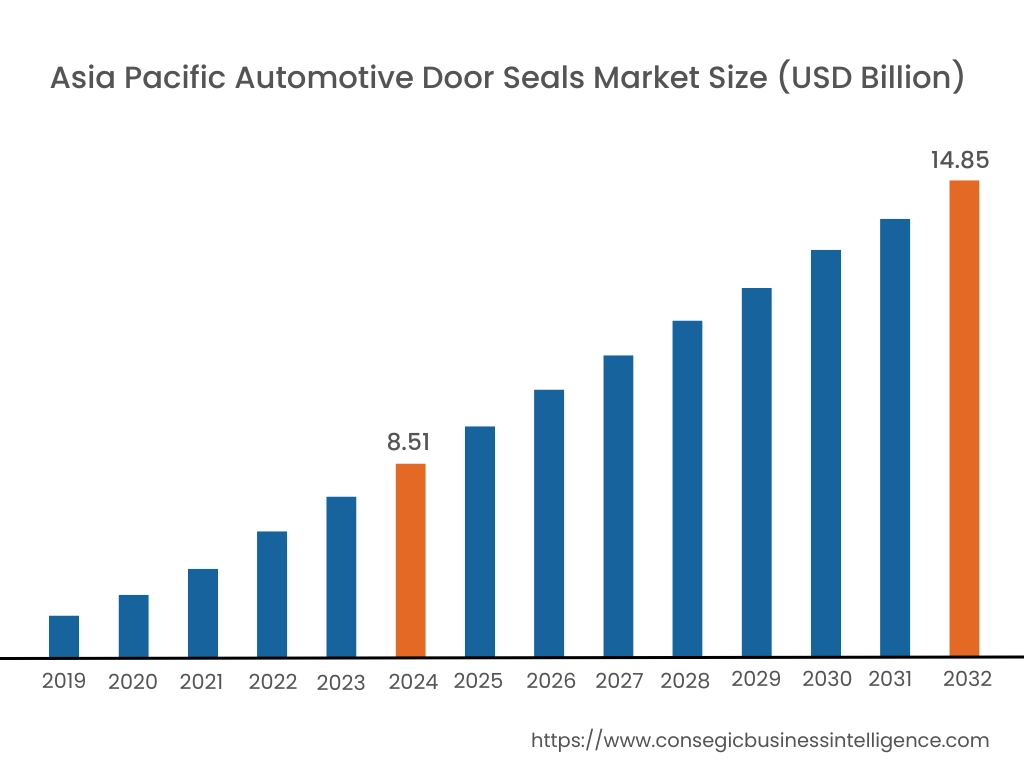
Asia Pacific automotive door seals market expansion is estimated to reach over USD 14.85 billion by 2032 from a value of USD 8.51 billion in 2024 and is projected to grow by USD 9.03 billion in 2025. Out of this, China automotive door seals industry accounted for the maximum revenue split of 34.33%. The Asia-Pacific region remains the market leader, with manufacturers benefiting from significant cost reductions due to access to low-cost labor and raw materials. This region includes China and India, which together represent around 34% of total vehicle production. Additionally, the anticipated growth driven by commercial and government investments, along with foreign direct investment participation, is expected to propel market development throughout the forecast period. In addition to this, China is now among the largest automobile markets globally, with a growing interest in electric vehicles driving development in high-performance door seals. The country is making significant investments in automotive research and development as domestic and international manufacturers increase production. Local companies are seeking lightweight and eco-friendly materials for door seals to comply with strict emission standards and improve vehicle efficiency. These factors would further supplement the regional automotive door seals market share during the forecast period.
- For instance, in 2023, China has become the largest producer of vehicles, with production increasing by 11.6% year-over-year to a total of 30.16 million vehicles. The increase production volume is expected to drive the global market for automotive sealing during the forecast period.
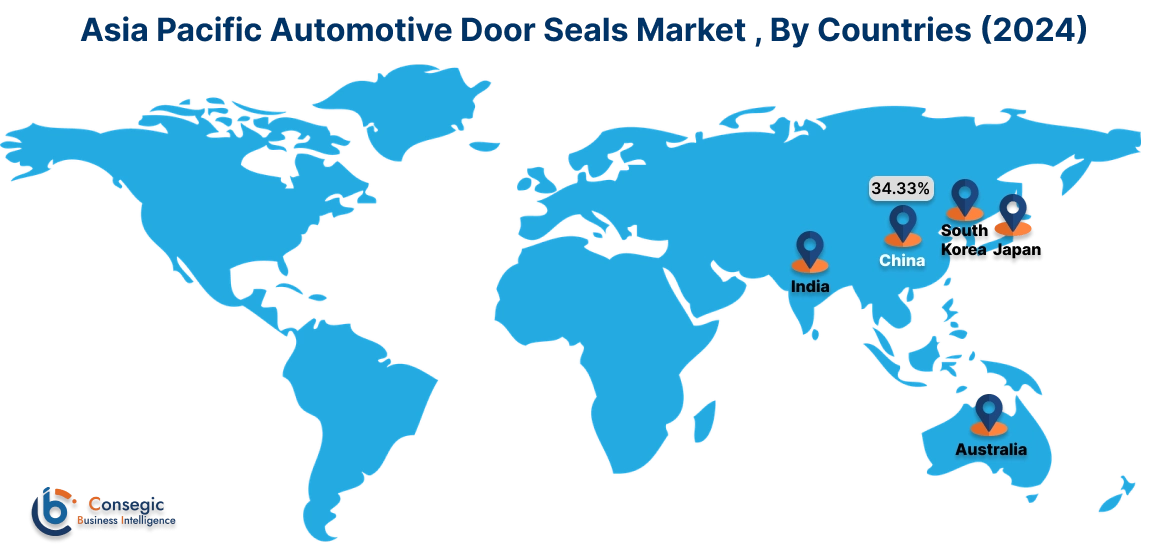
North America automotive door seals market growth is estimated to reach over USD 10.22 billion by 2032 from a value of USD 6.30 billion in 2024 and is projected to grow by USD 6.65 billion in 2025. North America represents a significant market for automotive door seals, which is fueled by the presence of key automotive manufacturers, such as General Motors, Tesla, and Ford, among others and a well-established automotive sector. Further, consumers in this region are increasingly in search of weather-resistant seals and noise-reducing that adapt to various climatic conditions. Additionally, the rising sales of electric vehicles in the Canada and U.S. are further fueling the need for enhanced door seals aimed at improving comfort and efficiency. These factors would further supplement the regional automotive door seals market share during the forecast period.
- For instance, in January 2024, according to reports by Kelley Book in 2023, 1.2 billion car buyers in the U.S. chose electric vehicles, which is accounted for 7.6% of the U.S. vehicle market, which is up from 5.9% in 2022. The increased sale of electric vehicles is expected to drive the market of door sealing.
As per the market analysis, the regional market in Europe is currently experiencing robust progression. Germany, renowned for its leading automakers such as BMW, Audi, and Mercedes-Benz, is a key player in the luxury vehicle market. The country's automotive sector prioritizes innovation in high-quality door seals aimed at minimizing cabin noise and enhancing thermal insulation. Furthermore, Germany's rigorous environmental regulations promote the use of eco-friendly sealing materials, delivering exceptional performance while aligning with sustainability objectives. Additionally, major automotive manufacturers in Latin America, including Hyundai and Kia, stand out due to their requirement for high-performance sealing solutions to enhance vehicle comfort, efficiency, and safety. Suppliers in the region have played a crucial role in addressing the demand for advanced sealing solutions. As the focus shifts toward eco-friendly vehicles and advancements in electric and hydrogen-powered vehicles by local companies, the need for advanced door seals has surged. Furthermore the MEA region has a significant presence in the market, attributed to the concentration of major automobile manufacturers. Additionally, the regional government's dedication to lowering vehicle emissions has encouraged automobile manufacturers to adopt advanced sealing technologies to comply with strict environmental regulations.
Top Key Players and Market Share Insights:
The global automotive door seals market is highly competitive with major players providing solutions to the national and international markets. Key players are adopting several strategies in research and development (R&D), product innovation, and end-user launches to hold a strong position in the market. Key players in the automotive door seals industry includes-
- Saga Elastomer Pvt. Ltd (India)
- Sujan Industries (India)
- Toyoda Gosei (Japan)
- Bohra Rubber Pvt. Ltd. (India)
- Hutchinson (France)
- GB Rubber Products (India)
- Trelleborg (Sweden)
- Avon Seals Pvt. Ltd. (India)
- Talbros Automotive Components (India)
- R K Industries (India)
Recent Industry Developments :
Expansion:
- In June 2023, Hutchinson opened its new BS O-rings and bushings distribution center in Château-Gontier-sur-Mayenne. The new distribution center improved quality of service and customized packaging for customers, automate and robotize the warehouse operations, and optimize the flow of operations through warehouse management system. This project also supports the group's carbon neutrality goals by incorporating top-standard interior and exterior insulation, photovoltaic panels on the roof to achieve energy autonomy, a rainwater recovery system, and transforming it into a positive energy building (BEPOS) that generates more energy than it consumes.
Automotive Door Seals Market Report Insights :
| Report Attributes | Report Details |
| Study Timeline | 2019-2032 |
| Market Size in 2032 | USD 44.24 Billion |
| CAGR (2025-2032) | 5.7% |
| By Type |
|
| By Material |
|
| By Application |
|
| By Vehicle Type |
|
| By Sales Channel |
|
| By Region |
|
| Key Players |
|
| North America | U.S. Canada Mexico |
| Europe | U.K. Germany France Spain Italy Russia Benelux Rest of Europe |
| APAC | China South Korea Japan India Australia ASEAN Rest of Asia-Pacific |
| Middle East and Africa | GCC Turkey South Africa Rest of MEA |
| LATAM | Brazil Argentina Chile Rest of LATAM |
| Report Coverage |
|
Key Questions Answered in the Report
How big is the Automotive Door Seals market? +
Automotive Door Seals Market Size is estimated to reach over USD 44.24 Billion by 2032 from a value of USD 26.93 Billion in 2024 and is projected to grow by USD 28.44 Billion in 2025, growing at a CAGR of 5.7%from 2025 to 2032.
Which is the fastest-growing region in the Automotive Door Seals market? +
Asia-Pacific is the region experiencing the most rapid growth in the market. The robust demand for automotive components and accessories for repair and maintenance is anticipated to propel the overall revenue of the Asia Pacific automotive aftermarket. Additionally, as e-commerce continues to expand, numerous parts and component manufacturers are investing in online platforms and utilizing sites like Amazon and eBay to reach online consumers.
What specific segmentation details are covered in the Automotive Door Seals report? +
The automotive door seals report includes specific segmentation details for component, frequency, application, end user and region.
Who are the major players in the Automotive Door Seals market? +
The key participants in the market are Saga Elastomer Pvt. Ltd (India), Sujan Industries (India), GB Rubber Products (India), Trelleborg (Sweden), Avon Seals Pvt. Ltd. (India), Talbros Automotive Components (India), R K Industries (India), Toyoda Gosei (Japan), Bohra Rubber Pvt. Ltd. (India), Hutchinson (France), and others.
